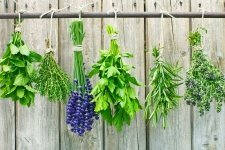Harvest Lemon Flavor in the Herb Garden
Fortunate are those gardeners who can grow their own lemons! But those of us who garden in climes too wintry for citrus can still harvest lemon flavor and scent from our gardens. Add a squeeze of lemon to your harvest by planting some of these herbs in your garden this season.
Lemon Balm
Melissa officinalis is a hardy Mediterranean perennial, growing 2 to 3 feet tall and as wide. Unless plants are cut back before the seeds disperse, they will self-sow. The leaves have a subtle lemon flavor and fresh lemon fragrance. Add the fresh younger leaves to green salads, fresh fruit, or cooked rice. Or lay fish or chicken on a bed of lemon balm before baking. When dried, the leaves are best used as a relaxing, calming hot tea.
Lemongrass
Cymbopogon citratus is a tropical grass, growing 2 to 4 feet tall, from Southeast Asia. Grow it as an annual or bring it indoors in the winter. The flavor is a combination of tart and peppery. Lemongrass is essential in preparing Southeast Asian dishes -- soups and curries -- but it can also flavor other foods, including sorbets and ice cream. Use only the lower 4 to 6 inches, chopping finely or bruising to release the flavor. The leafy parts of the stem make a relaxing tea. Use the stems fresh or freeze to preserve.
Lemon Verbena
Aloysia triphylla is a tropical deciduous shrub native to Chile and Argentina. Grow it as an annual or it bring indoors in winter, where it will remain dormant until spring. The leaves have a glorious and intoxicating scent and a strong lemon flavor without the sourness. Use the leaves in all kinds of drinks and desserts, but the flavor is best retained if left uncooked or only minimally heated. Much of the flavor is lost when leaves are dried; a better way to preserve it is to grind one part sugar with two parts lemon verbena leaves in a food processor and freeze.
Lemon Basil
Ocimum basilicum has small, intensely fragrant leaves. Like other basils, it is an annual. The best varieties are 'Sweet Dani' and 'Mrs. Burns', which grow 2 feet and 3 feet tall, respectively. They are excellent with fish or chicken, in soups, salads, pastas, and desserts. Or make an unusual homemade limonata or Italian lemonade, using both lemons and lemon basil. Make a lemon basil simple syrup by simmering 1 cup of fresh lemon basil leaves, 1 cup of sugar, and 1/2 cup of water for about 5 minutes. Cool and strain; then chill. Mix simple syrup with 1 cup of freshly squeezed lemon juice and 1 cup of water. Serve over ice.
Lemon Catnip
Nepeta cataria 'Citriodora' or 'Citrata' is a lemon-scented version of a cat's favorite perennial herb. Besides pleasing your feline friends, it also makes a good tea for the stomach or to aid sleep.
Lemon Geranium
This is just one scent among many of the scented geraniums. Pelargonium crispum 'Minor', commonly called fingerbowl geranium, has tiny, wrinkled leaves on stiff, upright stems. It was used to add a fresh lemon scent in fingerbowls at the Victorian dinner table. 'Frensham' has a more traditional look to its leaves, but it also has a delightful lemon scent. Use lemon geranium to scent sugar. Grow it as an annual or bring it indoors in winter.
Lemon Mint
This species was developed from apple and lime mints, and is known as 'Hilary's Sweet Lemon' mint. The fragrance is a combination of sweet, fruity, spearmint, and citrus. Use it in drinks or add it to salads and fresh fruit. Like most mints, it has aggressive perennial growth.
Lemon Thyme
There are at least nine or ten different perennial varieties of thyme called lemon thyme. For your main cooking needs, you want Thymus x citriodorus, with plain green leaves, or Thymus x citriodorus 'Aureus', with gold-edged leaves. Both thyme and citrus flavors are essential for cooking; lemon thyme gives you the best of both worlds!
Read more at The National Gardening Association.








